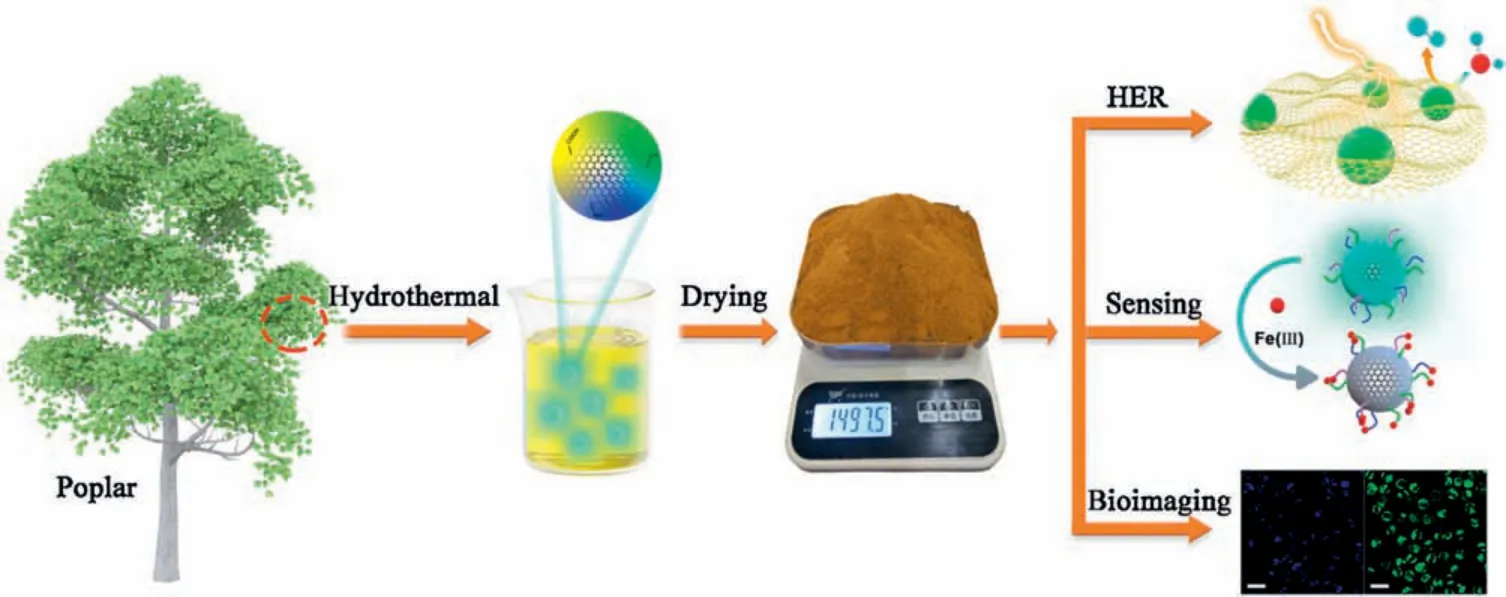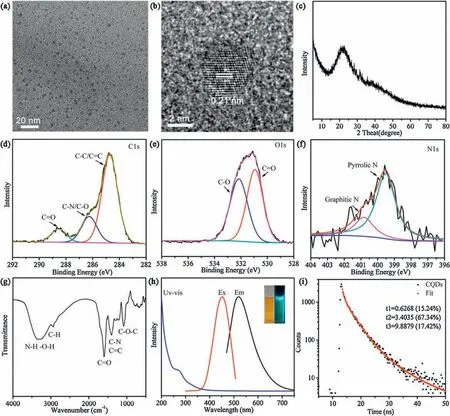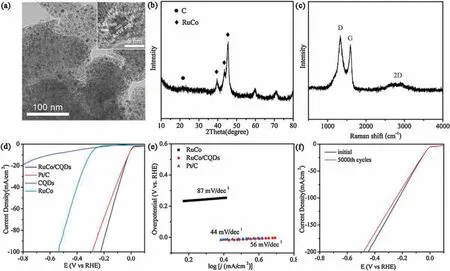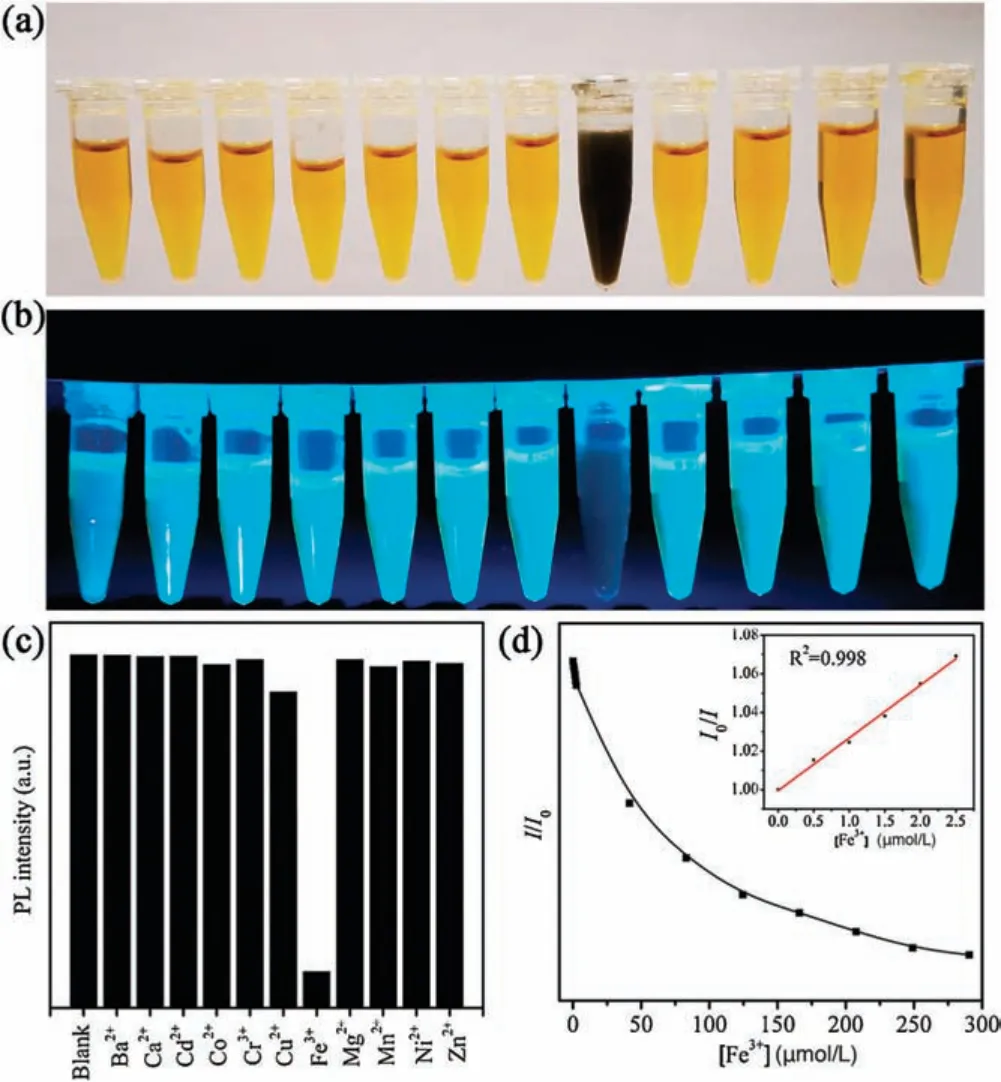Kilogram-scale synthesis of carbon quantum dots for hydrogen evolution, sensing and bioimaging
Weidong Li,Yun Liu,Boyng Wng,Hoqing Song,Zhongyi Liu,Siyu Lu,*,Bi Yng
a College of Chemistry, Zhengzhou University, Zhengzhou 450001, China
b College of Materials Science and Engineering, Zhengzhou University, Zhengzhou 450001, China
c State Key Laboratory of Supramolecular Structure and Materials, College of Chemistry, Jilin University, Changchun 130012, China
Keywords:
Kilogram-scale
Carbon quantum dots
Hydrogen evolution
Sensing
Bioimaging
ABSTRACT
The development of large-scale synthetic methods for high quality carbon quantum dots (CQDs) is fundamental to their applications.However,the macroscopic preparation and scale up synthetic of CQDs is still in its infancy.Here,we report a facile,green,kilogram-scale synthesis of high quality fluorescent CQDs derived from poplar leaves via a one-step hydrothermal method.Notably,the throughput of CQDs can reach a level up to as high as 1.4975 kg in one pot.The structure and properties of the as-prepared CQDs were assessed through TEM, XRD, XPS and various spectroscopic methods.The obtained high quality CQDs with a photoluminescent quantum yield of 10.64%showed remarkable stability in aqueous media, rich functional groups, high photostability, consistent photoluminescence within biological pH range and low cytotoxicity.On account of these good properties,we demonstrated the multifunctional application to electrocatalytic water splitting, Fe3+ sensing and bioimaging.It showed remarkable electrocatalytic activity, Fe3+ sensitivity and good biocompatibility.This study provides a green, facile,inexpensive and large-scale method for producing high quality CQDs,which provides application value for large-scale production of CQDs.
Carbon quantum dots (CQDs), a new class of fluorescent carbon nanomaterials with a size less than 10 nm have attracted much attention due to their advantages of excellent solubility[1],low toxicity [2], favourable biocompatibility [3,4]and tunable photoluminescence[5,6]which make them potential alternatives to heavy metal-based semiconductor quantum dots [7].Up to now, the CQDs has been widely applied in biosensing [8,9],nanomedicine [10], bioimaging [11-13], optoelectronics [14,15],catalysis [16-18], and energy conversion/storage [19,20].Therefore, the development of large-scale synthetic methods would greatly aid their transition from the research laboratory to practical application.
The traditional methods such as chemically or physically cutting large carbon precursors into small pieces of CQDs may involve several drawbacks such as multiple laborious fabrication steps,expensive starting materials,special equipment,strong acid(alkali) and high costs [21,22].However, the main concern is the low yield,which become the biggest barrier for the widespread use of CQDs.As an alternative, hydrothermal treatment was considered to be the most ideal method to prepare fluorescent CQDs,because it does not require severe synthetic conditions,and the asprepared CQDs has good solubility and it does not need further surface passivation [23-25].Biomass is not only abundant,sustainable and renewable, but also cheap, easily available.It provides an effective basis for the preparation of CQDs on largescale [26].So many researchers choose hydrothermal treatment biomass to prepare the fluorescent CQDs, such as garlic [27],cabbage[28],grass[29],algal blooms[30],orange juice[31],Onion[32].However, they rarely achieve the high synthetic yields necessary for scalable manufacture.A few works have been concerned with mass production [33-35], but the throughput of CQDs was generally still low(Table S1 in Supporting information).It should be noted that the strategy of large-scale preparation is of vital importance for the application of high quality CQDs.Thus,it is necessary and challenging to develop large-scale synthetic methods for CQDs.
In this work,we report a facile,green,kilogram-scale synthesis of high quality CQDs derived from poplar leaves using a one-step hydrothermal method.Importantly, the throughput of CQDs was 1.4975 kg in one pot.In the present research, this is the first time that kilogram-scale synthesis of high quality CQDs without any chemicals.The obtained CQDs showed excellent PL properties,high photostability, size uniformity, and low cytotoxicity.The surface of the as-prepared CQDs was highly functionalized with oxygen rich groups as well as nitrogen.Finally, the as-prepared CQDs were successfully applied to hydrogen evolution reaction(HER), selective detection of Fe3+and imaging of cells.This study not only provides green, efficient and renewable strategy for producing high quality CQDs,but also provides a method to scale up industrial production.
The CQDs were synthesized from poplar leaves by a typical onestep hydrothermal method at 200°C for 24 h (Scheme 1).After purification and drying,1.4975 kg brownish-yellow CQDs powder was obtained (Fig.S1 in Supporting information).Transmission electron microscopy (TEM) directly observed the morphology of the CQDs nanostructures and particle size distribution.The CQDs were uniformly dispersed with an average particle size of 3.26 nm(Fig.1a and Fig.S2 in Supporting information).High-resolution TEM (HRTEM) showed the lattice spacing of the CQDs is about 0.21 nm (Fig.1b), which corresponds to the (100) planes of graphitic carbon [21].The X-ray diffraction (XRD) was used to characterize the crystalline structure of CQDs.The broad peak at 22.40°(Fig.1c)is associated with a graphite structure and the(100)planes of carbon, which is consistent with the TEM data.
Detailed information about the elemental composition and surface chemical states of the as-synthesized CQDs was found by X-ray photoelectron spectroscopy (XPS).The survey spectrum presented(Fig.S3 in Supporting information)shows three typical peaks at 286.3 eV,531.0 eV,399.5 eV,which are attributed to C 1s,N 1s, and O 1s, indicate the CQDs composition to be mainly C(59.59%), O (38.19%) and N (2.23%).High-resolution XPS scans( Figs.1d-f)give further details.C 1s analysis reveals the presence of C--C/C=C at 284.7 eV,C--O/C--N at 286.2 eV and C=O at 288.5 eV.The peaks of O 1s band are 530.9 and 532.1 eV, which correspond to C=O and C--O,respectively.Deconvolution of the N 1s band into two peaks at 399.5 and 400.8 eV indicated pyrrolic N and graphitic N[4,21],respectively.The Fourier transform infrared(FT-IR) spectra was recorded to study the chemical composition and functional groups of the as-synthesized CQDs (Fig.1g).The broad absorption band at 3420 cm-1was assigned to--OH or--NH2.The band at 2930 cm-1, 1715 cm-1, 1407 cm-1,1071 cm-1was assigned to C--H, C=O, C=C/ C--N, C--O--C stretching [27], respectively.Overall, the FT-IR show satisfactory agreement with that of XPS data, intensively suggesting that the surface of the as-prepared CQDs was passivated by both oxygenand nitrogen-containing groups.
The CQDs aqueous exhibited bright blue-green fluorescence under irradiation with 365 nm UV light.The optical properties were further investigated.The UV-vis absorption spectrum(Fig.1h) exhibits two excitonic adsorption bands at about 275 nm and 325 nm,which were assigned to the π→π*transition of the aromatic domains and n→π*transitions between the oxygen-/nitrogen-containing groups and sp2domains,respectively[16].The PL simulated by excitation at 300-480 nm (at 20 nm increments)showed that the CQDs emission peak depended on the excitation wavelength (Fig.S4 in Supporting information), with optimal excitation at 460 nm inducing the strongest emission at 510 nm.The excitation-dependent PL might be attributable to the different particle sizes or the existence of diverse emissive traps on the surface of CQDs.The absolute fluorescence quantum yield was calculated to be 10.64% by using an integrating sphere.The fluorescence lifetime was obtained by time-correlated singlephoton counting(Fig.1i),an important technique for clarifying the behaviour of excited electrons [33].The CQDs were excited at 460 nm, and the emission was monitored at 510 nm.The mean lifetime (τ mean) was calculated to be 4.11 ns, indicating that the CQDs had only fluorescent properties.This suggests that the CQDs are potential candidates for optronic and biological applications.
The fluorescence stability of the as-synthesized CQDs was measured under 365 nm UV exposure from 0 to 15 h.As shown in Fig.S5 (Supporting information), the fluorescence intensity of CQDs had no decline.The pH stability was investigated at a range of pH values (Fig.S6 in Supporting information), the PL intensity remained relatively stable at pH 4-10,but decreased in strong base(pH 11-14)and strong acid(pH 1-3)solutions.The storage stability under ambient conditions was also measured and illustrated.It can be seen in Fig.S7 (Supporting information) that the fluorescence intensity has no obvious change over 25 days.All the results proved that the CQDs have an excellent stability.
Carbon quantum dots,with easy surface functionalization,high electric conductivity,are widely considered to design and fabricate catalysts.The abundant functional groups (such as -OH, -NH2,-COOH)on the surface of CQDs could provide many active sites for the fabrication of catalyst [21,25].Given these favourable properties,we fabricated a ruthenium-cobalt alloy/carbon quantum dots(RuCo/CQDs) hybrid material by mixing the CQDs with RuCl3and Co(NO3)2by a facile hydrothermal progress and then annealing at 600°C under Ar atmosphere.The morphology of RuCo/CQDs was first observed by TEM.As shown in Fig.2a, the sample was composed of well dispersed ruthenium-cobalt alloy nanoparticles with average size around 5 nm anchored in the graphitic carbon sheets.The HRTEM image shows the distinct contact between RuCo alloy and CQDs, which means the formation of multiple RuCo/CQDs interfaces.Such structural feature may facilitate the mass and charge transfer between RuCo alloy and CQDs, further improving the intrinsic electric properties of the hybrid material.The lattice spacings of 0.198 nm and 0.34 nm are attributed to the(101)planes of RuCo alloy and the(002)planes of graphite carbon,respectively.The structure of RuCo/CQDs was analyzed by XRD.As shown in Fig.2b,the peak at 22.40°is attributed to the(100)planes of carbon,the peaks at 39.9°,43.3°,45.6°,which correspond to the(100), (002), (101) facets of RuCo alloy, respectively [36].The composition and degree of graphitization of the as-synthesized sample was further revealed by Raman spectroscopy.As shown in Fig.2c, the Raman spectra was identified typical D (~1340 cm-1)and G(1572 cm-1)bands and a 2D bands at around 2703 cm-1.The D bands is ascribed to disordered carbon or defective carbon,and the G bands is attributed to sp2hybridized graphitic carbon [25].The relative intensity(ID/IG)ratios of RuCo/CQDs was calculated to be 1.16,indicated the large amounts of defects in the carbon layers.The broad and weak 2D band implies that the coated carbon was graphene with several layers.Overall, the RuCo/CQDs catalyst incorporated abundant active sites, including multiple interfaces of the alloy and defect-rich carbon sheets,and thus appeared as a promising electrocatalyst for the HER.

Scheme 1.Kilogram-scale synthesis of CQDs.

Fig.1.Characterisation of the as-synthesized CQDs:(a)TEM and(b)HRTEM images;(c)XRD pattern;high-resolution XPS spectra for(d)C 1s,(e)O 1s and(f)N 1s;(g)FT-IR spectrum; (h) UV-vis, PL emission, and PL excitation spectra in aqueous solution; (i) PL decay in aqueous solution at 510 nm under 420 nm excitation.
The hydrogen evolution reaction (HER) catalytic performance was tested in 1 mol/L KOH solution.The polarization curves without iR correction were obtained by linear sweep voltammetry(LSV) with a sweep rate of 5 mV/s.The loading of RuCo/CQDs catalyst was 0.42 mg/cm2.The HER performance was evaluated by observing the overpotential with respect to the reversible hydrogen electrode (RHE) at 10 mA/cm2, which is the current density expected for a 12.3% efficient solar water-splitting device[37].As shown in Fig.2d,the pure CQDs exhibited poor activity for the HER, as did the unsupported RuCo alloy nanoparticles.In remarkable contrast, the RuCo/CQDs performed much better, the onset potential was near 0 mV, and the overpotential at a current density of 10 mA/cm2was 16 mV,which is 3 mV lower than that of 20% commercial Pt/C.The Tafel plots of the electrocatalysts were compiled to investigate the mechanism of the HER (Fig.2e).The Tafel slope of the RuCo/CQDs was 56 mV/decade,much lower than that of the RuCo alloy (87 mV/decade), implying favourable catalytic kinetics for the HER and indicating that the HER at the hybrid's surface follows a typical Volmer-Heyrovsky mechanism rather than a Tafel step.
The durability of catalysts is another a key factor in evaluating performance.As shown in Fig.2f, after 5000 cyclic voltammetry(CV)cycles in 1 mol/L KOH solution,the overpotential of the RuCo/CQDs changed only 3 mV at 10 mA/cm2, which demonstrated its structural stability during the HER process.These results proved that the presence of a carbon layer could protect the alloy from aggregation, thus ensuring the long-term stability.The synergy originating from the interfaces between the alloy and the CQDs was further investigated through electrochemical surface area(ECSA) measurements and electrochemical impedance spectroscopy (EIS).As shown in Fig.S8 (Supporting information), the double-layer capacitance (Cdl) of RuCo/CQDs was 52.3 mF/cm2,which is higher than Pt/C (49.7 mF/cm2) or RuCo alloy nanoparticles(10.3 mF/cm2)and demonstrated their large surface area.The Nyquist plots in Fig.S9 (Supporting information) show RuCo/CQDs to possess a much smaller charge-transfer impedance(13.64 Ω)at an overpotential of 10 mV than Pt/C(15.91 Ω)or RuCo alloy nanoparticles (65.66 Ω).The large ECSA and fast electron transport of the multiple alloy/CQDs interfaces made the hybrid catalyst suitable for promoting the HER performance.

Fig.2.Characterization of the as-synthesized RuCo@CQDs:(a)TEM and HRTEM(inset)images;(b)XRD patterns;(c)Raman spectrum.HER performance:(d)polarization curves for RuCo@CQDs, CQDs, RuCo alloy and 20% commercial Pt/C; (e) Tafel plots for RuCo@CQDs, RuCo alloy and 20% commercial Pt/C; (f) durability of RuCo@CQDs in 1 mol/L KOH before and after 5000 cycles.
It is reported that the metal ion binding could change optical properties of CQDs.So CQDs are also considered to be metal ion sensors owing to their high aspect ratio and availability for many functional groups on their surface[8].The sensing ability of the asprepared CQDs were tested by measuring their fluorescence intensity upon the addition of various metal salts(50 mmol/L Mn2+,Ni2+,Cd2+,Cu2+,Cr3+,Co2+,Ba2+,Mg2+,Fe3+,Ca2+and Zn2+).The CQDs solution become black after the addition of Fe3+under visible light conditions(Fig.3a), and almost completely quenched the strong green-blue fluorescence under UV irradiation in the presence of Fe3+(Fig.3b and Fig.S10 in Supporting information).It was observed that the Fe3+recognition can be easily observed by the naked eye.The fluorescence intensity ratios (I/I0) relative to the solution without metal ions(Fig.3c)clearly showed great fluorescence quenching byFe3+(90.7%reduction)and minimal changes due to the other metal ions.These results clearly demonstrated the efficacy of the CQDs as a fluorescent sensor that was highly selective toward Fe3+over the other metal ions.Therefore, the detailed sensing response of the CQDs toward Fe3+ions was further studied.The fluorescence intensity gradually decreased as the concentration of Fe3+increased from 0.5 μmol/L to 290 μmol/L(Fig.3d and Fig.S11 in Supporting information), and the quenching followed the Stern-Volmer equation[8,32]:

where I0and I are the fluorescence intensity of the CQDs in the absence and presence of Fe3+,respectively,KSVis the Stern-Volmer quenching constant, and [Q]is the concentration of Fe3+.The obtained Stern-Volmer plot shown in the inset of Fig.3d exhibited a good linear relationship, fitting a very well conventional linear Stern-Volmer equation (KSV=12,240 L/mol, R2=0.998).The relatively large Stern-Volmer constant suggests that Fe3+causes static quenching from the formation of a stable non-fluorescent complex with the CQDs.Overall, all the results clearly demonstrated that the specific effect of Fe3+ions on the fluorescence of the CQDs makes the CQDs potentially useful for the selective sensing of Fe3+ions.

Fig.3.The digital photographs of CQDs with various metal ions under(a)day light and(b)UV light(365 nm);(c)Fluorescence intensity of CQDs toward various ions;(d) The fluorescence intensity ratio I/I 0 of the CQDs solution in the presence of different concentration of Fe3+ ions (from 0.5 μmol/L to 290 μmol/L).Inset: the Stern-Volmer plot of the quenching of the fluorescence of CQDs by Fe3+.
As expected, the CQDs are considered as multicoloured fluorescent probes for bioimaging [13,34].The cytotoxicity of the CQDs was evaluated via MTT viability assay using K562 cells.The cells were incubated in different concentrations CQDs solutions for 24 h.As shown in Fig.S12 (Supporting information),the CQDs exhibited extremely low cytotoxicity, the relative cell viability was almost not decrease at 50 μg/mL after 24 h cultured.When the concentration was raised to 250 μg/mL,the relative cell viability was 91%.All the result indicated that the CQDs were not potentially toxic at these levels and for this duration.
The cell imaging was studied by using the as-prepared CQDs as a fluorescence probe.The K562 cells were incubated with the asprepared CQDs at a safe level (250 μg/mL), and observed by confocal fluorescence microscopy.As shown in Fig.S13 (Supporting information), the multicolour CQDs were capable of labelling the cells.The K562 cells appeared blue under 405 nm laser light(Fig.S13b) and green under 488 nm irradiation (Fig.S13c), while untreated cells showed no emission under the same laser excitation (Fig.S14 in Supporting information).These results reveal the capability of these CQDs to readily penetrate the cell membranes but not enter the nuclei.The biocompatibility and low cytotoxicity of the CQDs were further confirmed by the lack of significant morphological damage to the cells.Overall, the CQDs appeared promising for drug delivery, fluorescent probes, biosensing, and other biomedical uses.
In summary, we have successfully prepared high quality fluorescent carbon quantum dots on a kilogram-scale through a one-step hydrothermal without any chemicals from poplar leaves.The throughput of CQDs can reach up to as high as 1.4975 kg.The surfaces of the as-prepared CQDs were highly functionalized with oxygen- and nitrogen-containing groups.The CQDs exhibited excellent dispersibility in the solution with a uniform size of≈3.26 nm,long-term stability,outstanding photostability and low cytotoxicity.Importantly, the obtained CQDs exhibited excellent electrical conductivity and support in electrocatalysts.We have fabricated a RuCo/CQDs hybrid material for hydrogen evolution reaction, which exhibits excellent catalytic performance with an overpotential of 16 mV, a Tafel slope of 47 mV/decade.The excellent sensing efficiency of the as-prepared CQDs toward the Fe3+ions was proved in the water samples.The bioimaging results display great potential of the CQDs for biological probe.Using poplar leaves for the synthesis of CQDs represents a green,economic, efficient, and environmentally friendly way, which is a successful large-scale commercial method for the preparation of CQDs.
Acknowledgment
The authors gratefully acknowledge financial support from Project funded by China postdoctoral Science Foundation (No.2018M640681).
Appendix A.Supplementary data
Supplementary material related to this article can be found,in the online version,at doi:https://doi.org/10.1016/j.cclet.2019.06.040.
 Chinese Chemical Letters2019年12期
Chinese Chemical Letters2019年12期
- Chinese Chemical Letters的其它文章
- Post-self-repair process of neuron cells under the influence of neutral and cationic nanoparticles
- CdS nanocrystallites sensitized ZnO nanorods with plasmon enhanced photoelectrochemical performance
- A simple visual method for DNA detection based on the formation of gold nanoparticles
- Self-assembly of L-tryptophan on Cu(111)studied by low-temperature scanning tunneling microscopy
- Functional delivery vehicle of organic nanoparticles in inorganic crystals
- Facile assembly of mesoporous silica nanoparticles with hierarchical pore structure for CO2 capture
